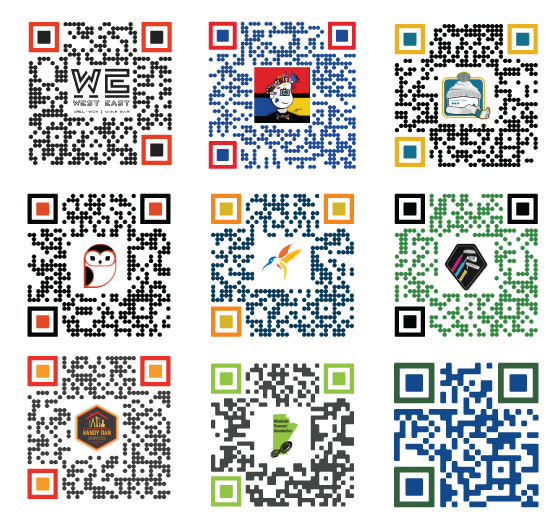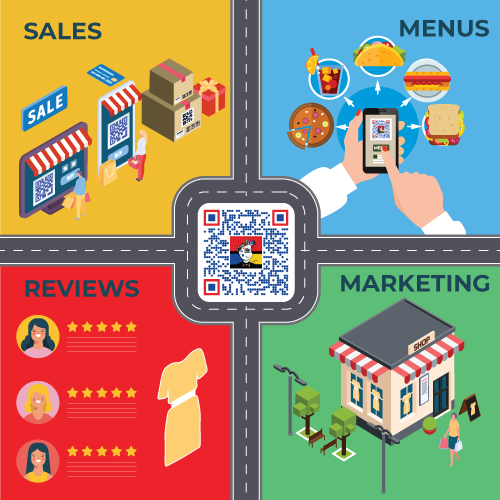QR Codes
A QR code is characterized by a two-dimensional pattern of square black and white dots. With this pattern, it is possible to imbed 200 times more information than a standard barcode.
QR codes are ubiquitous as we see them everywhere these days, from menus, virtual business cards, art galleries, and more. Invented by Denso engineer Hara Masahiro invented the QR code 25 years ago as a way to keep track of parts. Hara recounts. “Employees got tired of having to scan boxes multiple times, and this led us to come up with a code that would enable a large volume of information to be conveyed in a single scan.”
Hara explains that the inspiration for the technology came from his penchant for playing strategy games: “I used to play go on my lunch break. One day, while arranging the black and white pieces on the grid, it hit me that it represented a straightforward way of conveying information. It was a eureka moment.” Get more information at nippon.com >
Today billions of people around the world engage with QR technology as the newer phones have scanners built in such as the new iPhones which have a built in QR scanner eliminating the need for a third party app, thus making it easy for any user to instantly get access.
As the amount of people who use QR codes is growing, so are the uses for them. There are an infinite number of reasons to use QR scans in everyday life, Such as;
- Extending your print media reach: Creating a poster, brochure, signs, business cards with a customized QR code creates a instant engagement.
- Boost Your App: Chick-fil- A saw a 14 percent increase in mobile app downloads after using a QR Code on digital signage to promote it. The Software Store QR Code makes it simple for clients to download your app by linking to Apple App Store, Google Play Store, or Amazon Appstore by linking to numerous app shops. You may also link to a video teaser or a website with a customized button from the mobile-friendly page.
- Redeem Coupons: By enabling clients to quickly scan and promptly save or utilize your offer, the Coupon QR code is ideal for aiding in the optimization of your coupon campaign.
- Get More Followers: Add a Social Media QR Code to your storefront display or brochures if you want to ensure that customers are aware of all your newest news on their preferred platforms. They can connect to either your Twitter or Instagram with only one scan.
- Get More Reviews: Customers rarely provide feedback in an easy way, and even when they do, firms are sometimes left with a mountain of forms to sort through and arrange. However, that is no longer required. You now have a practical approach to gather client feedback and data directly to your preferred email address thanks to the Feedback QR Code. You may quickly refresh the information at any moment based on the product or service you want to learn the most about thanks to its division into categories and subcategories.
- Promote Your Event: With the Event QR Code, you may boost the success of your event marketing campaigns and attract more guests. By including more details with the Code, you make sure prospective customers can save the dates of your event on their preferred mobile calendar, access Google Maps for directions, and register for or buy tickets in advance to make planning easier.
- Menus on the Go: Make it possible for your patrons to view your menu while they are on the go by using PDF QR Codes. Additionally, you may easily change the PDF QR Code without having to reprint it if you add or remove menu items or rename your business.
DYNAMIC QR CODES vs STATIC QR CODES
Actionable insights at the palm of your hand.
Measure your QR Code campaign’s success as it happens. Track where and how many people scan your Codes then export the data into shareable CSV reports.
First off, there are actually two main categories of QR Codes: static and dynamic. Your intended usage of the QR Code will determine which type you use. Let’s examine the distinctions.
Dynamic QR Codes are trackable, so when they are finished being used, records of their use can be kept. This includes specifics like the scan’s location, its size, how many scans there were, when they happened, and the device’s operating system. The ability to edit dynamic QR codes at any time is their main benefit. This is obviously very helpful if there were any errors in the related information. Additionally, it is strongly advised to use Dynamic QR Codes if you intend to modify QR Code campaigns while they are active. This will enable you to make any necessary adjustments.
The other kind of QR code is a static one, which cannot be changed and cannot be tracked. This kind of QR Code is commonly created as an SMS QR Code, Plain Text QR Code, and a few other variations. For personal use, such as a one-time event where tracking is not crucial, static QR codes are more appropriate.
What are the most important QR Code metrics?
Operating system
Most consumers use their smartphones to scan QR Codes. Android, iOS, Windows, and other operating systems are used by different types of cell phones. This report identifies the prevalent phone models for your QR Code campaign.
Location (city & country)
The scan locations can be categorized by nation and city, with the number of scans in each category represented as a % of the total. Based on an individual’s IP address, this data is provided.
Total number of scans
This measure displays the total number of times a QR Code was scanned, including the number of times a single person scanned the code. This data is helpful, especially when contrasted to other factors like location and time.
Unique scans
Unique scans, which differ somewhat from total scans, represent the total number of times one user has scanned a QR Code. The amount of scans per device is essentially how the scans are tracked. Therefore, even if many devices have the same IP address, they will all be located at the same place but still count as separate scans. In contrast to unique scans, the total number of scans may consequently yield slightly inflated results.
Time period (month, day, hour)
The month, day, and even the hour are broken down into separate metrics for QR code scanning that are all displayed as real-time data. If you want to compare the effectiveness of advertising over different time periods, this data is really helpful.
ROI (return on investment)
To learn more about QR codes visit here!
QR Code tracking with Google Analytics
Linking your Google Analytics account to the QR Code is a crucial last step in tracking QR Code usage. The best free tool for monitoring the numbers behind all of your marketing efforts is Google Analytics. Google Analytics should be installed on each and every website. It’s crucial to keep track of the visitors who were referred as a result of the QR Code scan, especially if you are directing traffic to a website. The best way to measure return on investment is to track which users made purchases on this website page as a result of this referral.
Try out some of these custom QR codes:



